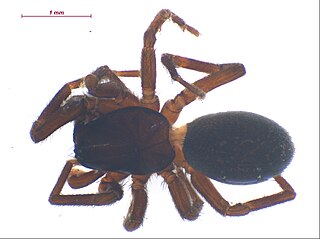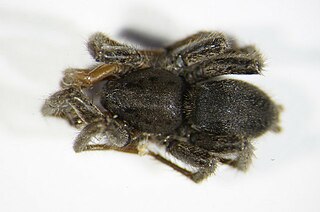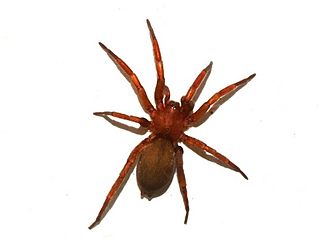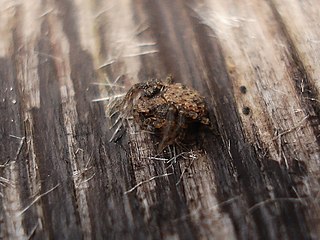
Wolf spiders are members of the family Lycosidae, from the Ancient Greek word "λύκος" meaning "wolf". They are robust and agile hunters with excellent eyesight. They live mostly in solitude and hunt alone, and do not spin webs. Some are opportunistic hunters pouncing upon prey as they find it or even chasing it over short distances. Some wait for passing prey in or near the mouth of a burrow.

Tegenaria is a genus of fast-running funnel weavers that occupy much of the Northern Hemisphere except for Japan and Indonesia. It was first described by Pierre André Latreille in 1804, though many of its species have been moved elsewhere. The majority of these were moved to Eratigena, including the giant house spider and the hobo spider.

Amaurobiidae is a family of three-clawed cribellate or ecribellate spiders found in crevices and hollows or under stones where they build retreats, and are often collected in pitfall traps. Unlidded burrows are sometimes quite obvious in crusty, loamy soil. They are difficult to distinguish from related spiders in other families, especially Agelenidae, Desidae and Amphinectidae. Their intra- and interfamilial relationships are contentious. According to the World Spider Catalog, 2019, the family Amaurobiidae includes about 275 species in 49 genera.
Pireneitega is a genus of funnel weavers first described by Kyukichi Kishida in 1955.
Amaurobius antipovae is a species of spider in the family Amaurobiidae, found in Russia and Georgia.

Cheiracanthiidae is a family of araneomorph spiders first described by Johann Andreas Wagner in 1887. The synonym Eutichuridae was used for a long time, but Cheiracanthiidae has priority. The largest genus currently recognized as belonging to this family is Cheiracanthium, which has previously been placed in both the Clubionidae and the Miturgidae.

Micaria is a genus of ground spiders that was first described by Niklas Westring in 1851. They are 1.3 to 6.5 millimetres long.
Devade is a genus of cribellate araneomorph spiders in the family Dictynidae, and was first described by Eugène Simon in 1884. Originally placed with the Amaurobiidae, it was moved to the intertidal spiders in 1983, then to the Dictynidae in 1989.
Scotolathys is a monotypic genus of cribellate araneomorph spiders in the family Dictynidae containing the single species, Scotolathys simplex. It was first described by Eugène Simon in 1884, and separated from Lathys into its own genus in 2009. Species occur in Algeria, Spain, Macedonia, Greece, Ukraine, and in Israel.

Tricholathys is a genus of cribellate araneomorph spiders in the family Dictynidae, and was first described by R. V. Chamberlin & Wilton Ivie in 1935.
Synaphris is a genus of araneomorph spiders in the family Synaphridae, and was first described by Eugène Louis Simon in 1894. Originally placed with the tangle web spiders, it was moved to the Symphytognathidae in 1973, and to the Synaphridae in 2003.
Carpathonesticus caucasicus is a species of araneomorph spider of the family Nesticidae. It occurs in Georgia, where it is found in caves.

Berlandina is a genus of ground spiders that was first described by R. de Dalmas in 1922.

Haplodrassus is a genus of ground spiders that was first described by R. V. Chamberlin in 1922. They range from 3 to 10 millimetres. H. signifer is the most widespread species, found across North America except for Alaska and northern Canada.
Parasyrisca is a genus of ground spiders that was first described by E. Schenkel in 1963. Originally placed with the sac spiders, it was moved to the Miturgidae in 1967, then to the ground spiders in 1988.
Synaphosus is a genus of ground spiders that was first described by Norman I. Platnick & M. U. Shadab in 1980.

Cozyptila is a genus of crab spiders that was first described by Y. M. Marusik, Pekka T. Lehtinen & M. M. Kovblyuk in 2005. As of July 2020 it contains three species, found in Europe and on Cyprus: C. blackwalli, C. guseinovorum, and C. nigristernum.
Shaitan is a monotypic genus of ground spiders containing the single species, Shaitan elchini. It was first described by M. M. Kovblyuk, Z. A. Kastrygina & Yuri M. Marusik in 2013, and has only been found in Russia, Azerbaijan, and Kazakhstan.

Pseudomogrus is a genus of jumping spiders first described by Eugène Simon in 1937.









